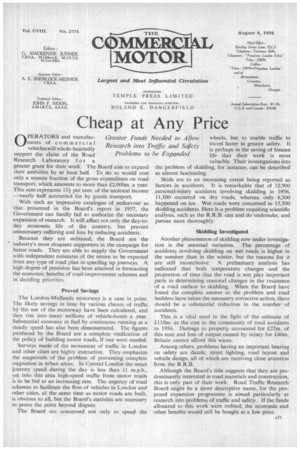Cheap at Any Price
Page 33

If you've noticed an error in this article please click here to report it so we can fix it.
Greater Funds Needed to Allow Research into Traffic and Safety Problems to be Expanded
OPERATORS and manufacturers of commercial vehicles will whole-heartedly support the claim of the Road Research Laboratory f or a greater grant for their work. The Board aim to expand their activities by at least half. To do so would cost only a minute fraction of the gross expenditure on road transport, which amounts to more than £2,000m. a year. This sum represents 131 per cent. of the national income —nearly half accounted for by goods transport.
With such an impressive catalogue of endeavour as that presented in the Board's report in 1957, the Government can hardly fail to authorize the necessary expansion of research. Tt will affect not only the day-today economic life of the country, but prevent unnecessary suffering and loss by reducing accidents.
Because they are unbiased, the Board are the industry's most eloquent supporters in the campaign for better roads. They are able to supply the Government with independent estimates of the return to be expected from any type of road plan in speeding up journeys. A high degree of precision has been attained in forecasting the economic benefits of road-improvement schemes and in deciding priorities.
Proved Savings The London-Midlands motorway is a case in point. The likely savings in time by various classes of traffic by the use of the motorway have been calculated, and they run into many millions of vehicle-hours a year. Substantial economy in fuel by continuous running at a steady speed has also been demonstrated. The figures produced by the Board are a complete vindication of the policy of building motor roads, if one were needed.
Surveys made of the movement of traffic in London and other cities are highly instructive. They emphasize the magnitude of the problem of preventing complete stagnation in urban areas. In Central London the mean journey speed during the day is less than 11 m.p.h., yet into this area high-speed traffic from motor roads is to be fed at an increasing rate. The urgency of road schemes to facilitate the flow of vehicles in London and other cities, at the same time as motor roads are built, is obvious to all, but the Board's statistics are necessary to prove the point beyond dispute.
The Board are concerned not only to speed the wheels, but to enable traffic to travel faster in greater safety. It is perhaps in the saving of human life that their work is most valuable. _Their investigations into the problem of skidding, for instance, can be described as almost fascinating.
Skids are to an increasing extent being reported as factors in accidents. It is remarkable that of 32,900 personal-injury accidents involving skidding in 1956, 11,100 occurred on dry roads, whereas only 6,300 happened on ice. Wet roads were concerned in 15,500 skidding accidents. Here is a problem requiring scientific anilysis, such as the R.R.B. can and do undertake, and pursue most thoroughly.
Skidding Investigated Another phenomenon of skidding now under investigation is the seasonal variation. The percentage of accidents involving skidding on wet roads is higher in the summer ,than in the winter, but the reasons for it are still inconclusive. A preliminary analysis has indicated that both temperature changes and the proportion of time that the road is wet play important parts in determining seasonal changes in the resistance of a road surface to skidding. When the Board have found the complete answer to the problem and road builders have taken the necessary corrective action, there should be a substantial reduction in the number of accidents.
This is a vital need in the light of the estimate of £110m. as the cost to the community of road accidents in 1956. Damage to property accounted for £27m. of this sum and loss of output caused_by injury for £40m. Britain cannot afford this waste.
Among others, problems having an important bearing on safety are dazzle, street lighting, road layout and vehicle design, all of which are receiving close attention from the R.R.B.
Although the Board's title suggests that they are predominantly interested in road materials and construction, this is only part of their work. Road Traffic Research Board might be a more descriptive name, for the proposed expansion programme is aimed particularly at research into problems of traffic and safety. If the funds allocated to this work were trebled, the economic and other benefits would still be bought at a low price.




































































































